 Whatever we do and wherever we leave our contact data, much of the email we get every day consists of outright spam and automated email newsletters. We’ve become so used to the latter that in most cases we delete them, mark them as read, or, if we are feeling particularly annoyed, we may even unsubscribe.
Whatever we do and wherever we leave our contact data, much of the email we get every day consists of outright spam and automated email newsletters. We’ve become so used to the latter that in most cases we delete them, mark them as read, or, if we are feeling particularly annoyed, we may even unsubscribe.
Nevertheless, they still keep coming, and any online marketer knows that email marketing is an important part of any promotional campaign. And every now and then a newsletter emerges that is actually good, that does its job properly, makes us want to read it and persuades us to convert. These rare examples happen when a marketer manages to leverage new and popular trends in email marketing. So what were these trends?
Responsive design. Modern newsletters should be designed to be read with equal convenience on any device, be it PC, smartphone or tablet. Attention to mobile devices is especially important, as no less than 67 percent of emails today are read on smartphones and tablets – and this share continues to grow stably. You can expect that an email that displays incorrectly on mobile will be deleted in less than 3 seconds.
Segmented campaigns. According to MailChimp, recipients are almost 75 percent more likely to click on emails from segmented campaigns than from non-segmented ones. No less than 83 percent of businesses have already implemented at least basic segmentation, and its sophistication continues to grow.
AI solutions. Companies already use machine learning to improve their strategies, come up with better subject lines, predict lead behavior and make emails more personalized, and as this sphere develops further we are likely to see it getting even more widespread – global automated email marketing is expected to account for $2.7 billion by 2025.
The question is, what changes can you make to your email marketing in 2019 stay relevant? Here are three things to consider:
1. Decrease the overall amount of email you send
What it really means
It may sound counter-intuitive, but one of the ways you can quickly improve the efficiency of your email marketing is by significantly scaling down its usage. If currently you habitually send an email every few days, try doing it once a week or even less frequently and do your best to stick to only the most relevant information.
Why you should do it
When you think about it, there is nothing surprising about it.
- The more emails a customer receives from you, the more routine they become and the more likely they will be perceived as spammy. According to HubSpot, 78 percent of consumers report having unsubscribed from newsletters because a brand was sending too many emails.
- Too many emails can negatively affect deliverability. As spam filters get smarter with the application of machine learning, the more often you send emails, the more suspicious your messages will seem to spam filters.
Examples
Dropbox. When you don’t use their products, many companies tend to pester you with emails about how awesome they are and suggesting that you give it a try. Dropbox takes a diametrically different approach – they send such emails only occasionally and keep them short, to the point and a bit whimsical. It’s not intrusive – it’s a gentle nudge.
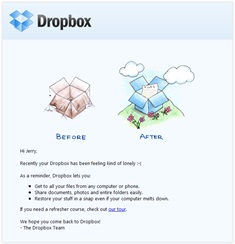
Source: https://blog.hubspot.com/hs-fs/hub/53/file-2562063987-png/dropbox-email-example.png?width=644&height=670&name=dropbox-email-example.png
Nike. Instead of barraging recipients with new offers every week, Nike sends a single minimalistic seasonal email, giving you just enough time to buy what you need for the coming season. Being a rare event, it makes the offer seem weightier and increases the chance of clicks and conversions.
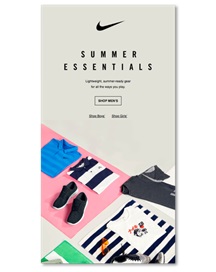
Source: https://media.coschedule.com/uploads/nike-email-example.png
2. Find balance between personalization and privacy
What it really means
In 2019, you must walk a thin line between over intrusive data collection activities, and not providing your clients with a sufficiently personalized experience.
Why you should do it
Here we see two conflicting trends. On the one hand, customers are getting more and more annoyed at and distrustful of companies collecting their personal data. A recent survey by Sailthru shows that 60 percent of customers are uncomfortable about their information getting collected, bought and sold. On the other hand, customers have already gotten used to personalization – 33 percent of consumers admit that the main reason they unsubscribe is because they don’t receive recommendations sufficiently tailored to their interests.
In addition to that, beyond GDPR, we are likely to see more legislation limiting businesses’ ability to collect data, so get ready for it.
Examples
Mom and Dad Money. By being straightforward, and pulling no punches, Mom and Dad Money’s email helps to build trust with its clients.
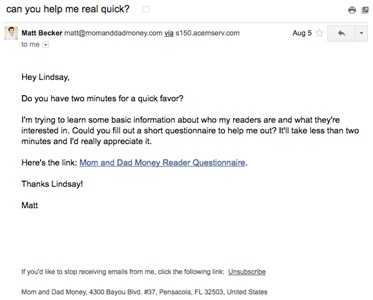
Source: https://blog.hubspot.com/hs-fs/hubfs/matt-becker-email-example.png?noresize&width=662&height=533&name=matt-becker-email-example.png
Stitcher. Stitcher is careful to show you why it collects your data – because it cares about you and your preferences and wants you to have a better experience. Recommendations it provides show that this is truly so.

Source: https://blog.hubspot.com/hs-fs/hub/53/file-2565376674-png/stitcher-email-example.png?width=669&name=stitcher-email-example.png
3. Use plain text emails
What it really means
It seems obvious that beautifully designed, HTML based emails get the best results, right? Wrong! For very good reasons, more and more businesses forgo image-rich and interactive emails in favor of simpler, often plain-text ones.
Why you should do it
- A study by HubSpot demonstrates that while users claim to prefer image-rich emails, plain-text ones win in every A/B test. Also, the more coded elements and images your email contains, the more likely it is to be treated as spam by the recipient’s email provider.
Examples
Hotjar. A plain-text email doesn’t have to look ugly, which is demonstrated by Hotjar and its use of visually-appealing fonts and carefully selected colors.
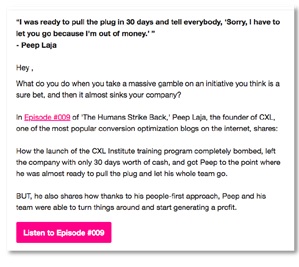
Source: https://media.coschedule.com/uploads/hotjar-email-sample.png
Siege Media. Again, while the email is in plain text, it is made easy to read and pleasant to look at through the use of short single-sentence paragraphs and immediately cutting to the chase (bonus points for being mobile-friendly).
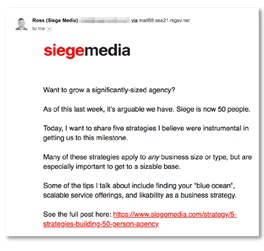
Source: https://media.coschedule.com/uploads/siege-media-email-example.png
Take charge of 2019 by effectively making changes in your marketing strategy
While we’ve already seen the beginnings of these trends in 2018, they are likely to get really big in 2019, changing the overall landscape of email marketing campaigns. Adopting them early on can mean all the difference between being the first to reap huge benefits and jumping on the bandwagon later on with everyone else.
Here are a few final tips to help you going forward:
- Don’t be pushy. Instead of trying to be active in terms of quantity, be meticulous about keeping your emails of the highest quality.
- If you’re lacking content to promote via email, why not use the content you’ve already created? Repurposing content from your blog can be part of an email marketing strategy.
- Be straightforward and transparent with your audience to build trust. Customers are irritated when their personal data is collected but still prefer personalized emails over general ones.
- Don`t be afraid of using plain text instead of images and gifs. Break the rules and common illusions about digital marketing.